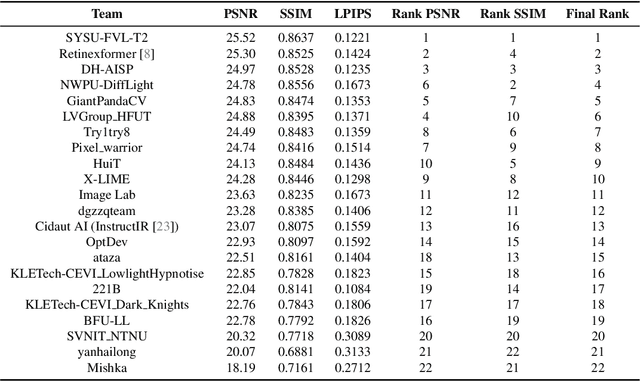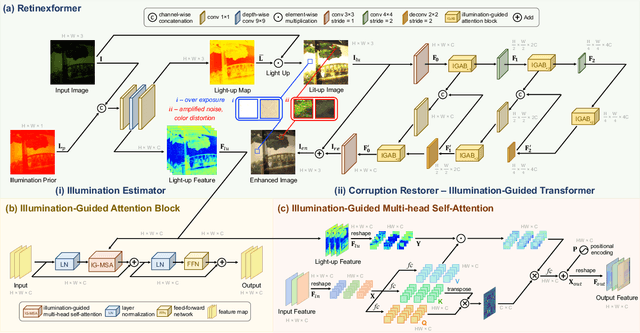Xiaoning Liu
NTIRE 2024 Challenge on Low Light Image Enhancement: Methods and Results
Apr 22, 2024



Abstract:This paper reviews the NTIRE 2024 low light image enhancement challenge, highlighting the proposed solutions and results. The aim of this challenge is to discover an effective network design or solution capable of generating brighter, clearer, and visually appealing results when dealing with a variety of conditions, including ultra-high resolution (4K and beyond), non-uniform illumination, backlighting, extreme darkness, and night scenes. A notable total of 428 participants registered for the challenge, with 22 teams ultimately making valid submissions. This paper meticulously evaluates the state-of-the-art advancements in enhancing low-light images, reflecting the significant progress and creativity in this field.
PASTA: Towards Flexible and Efficient HDR Imaging Via Progressively Aggregated Spatio-Temporal Aligment
Mar 15, 2024



Abstract:Leveraging Transformer attention has led to great advancements in HDR deghosting. However, the intricate nature of self-attention introduces practical challenges, as existing state-of-the-art methods often demand high-end GPUs or exhibit slow inference speeds, especially for high-resolution images like 2K. Striking an optimal balance between performance and latency remains a critical concern. In response, this work presents PASTA, a novel Progressively Aggregated Spatio-Temporal Alignment framework for HDR deghosting. Our approach achieves effectiveness and efficiency by harnessing hierarchical representation during feature distanglement. Through the utilization of diverse granularities within the hierarchical structure, our method substantially boosts computational speed and optimizes the HDR imaging workflow. In addition, we explore within-scale feature modeling with local and global attention, gradually merging and refining them in a coarse-to-fine fashion. Experimental results showcase PASTA's superiority over current SOTA methods in both visual quality and performance metrics, accompanied by a substantial 3-fold (x3) increase in inference speed.
Perceptual Multi-Exposure Fusion
Oct 19, 2022



Abstract:As an ever-increasing demand for high dynamic range (HDR) scene shooting, multi-exposure image fusion (MEF) technology has abounded. In recent years, multi-scale exposure fusion approaches based on detail-enhancement have led the way for improvement in highlight and shadow details. Most of such methods, however, are too computationally expensive to be deployed on mobile devices. This paper presents a perceptual multi-exposure fusion method that not just ensures fine shadow/highlight details but with lower complexity than detailenhanced methods. We analyze the potential defects of three classical exposure measures in lieu of using detail-enhancement component and improve two of them, namely adaptive Wellexposedness (AWE) and the gradient of color images (3-D gradient). AWE designed in YCbCr color space considers the difference between varying exposure images. 3-D gradient is employed to extract fine details. We build a large-scale multiexposure benchmark dataset suitable for static scenes, which contains 167 image sequences all told. Experiments on the constructed dataset demonstrate that the proposed method exceeds existing eight state-of-the-art approaches in terms of visually and MEF-SSIM value. Moreover, our approach can achieve a better improvement for current image enhancement techniques, ensuring fine detail in bright light.
 Add to Chrome
Add to Chrome Add to Firefox
Add to Firefox Add to Edge
Add to Edge